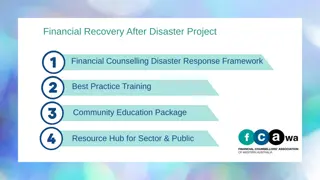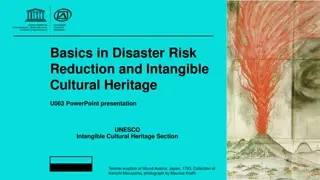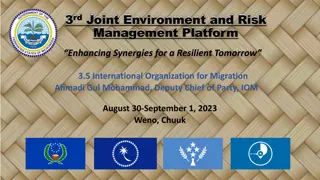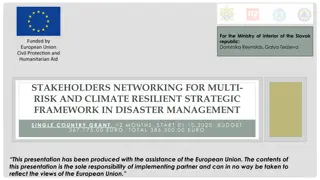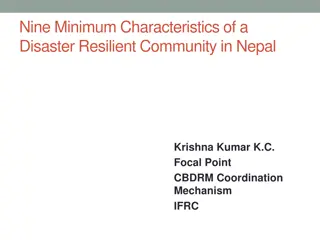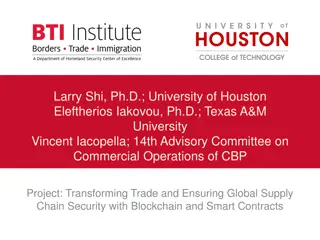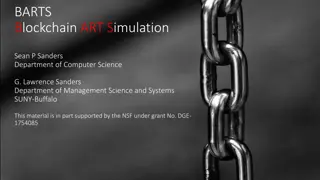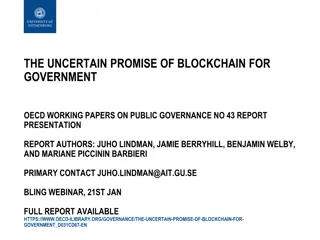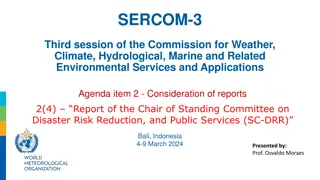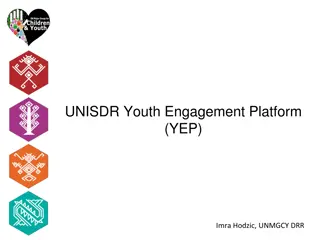Blockchain for Disaster Risk Reduction (DRR) Processes: Enhancing Response and Resilience
Blockchain technology offers a decentralized and transparent approach that can revolutionize Disaster Risk Reduction (DRR) processes. By providing secure and immutable records, blockchain can streamline asset registration, enhance data access control, enable smart contracts, track DRR impact funds, improve health data infrastructure management, facilitate predictive modeling for disaster risk, support carbon accounting and trading, optimize resource allocation, and strengthen monitoring of GPS and IoT data. The applications of blockchain in DRR span from shorter response times to longer-term prevention and mitigation strategies, addressing risks, governance, resilience, and preparedness across various natural and man-made disasters.
Download Presentation

Please find below an Image/Link to download the presentation.
The content on the website is provided AS IS for your information and personal use only. It may not be sold, licensed, or shared on other websites without obtaining consent from the author.If you encounter any issues during the download, it is possible that the publisher has removed the file from their server.
You are allowed to download the files provided on this website for personal or commercial use, subject to the condition that they are used lawfully. All files are the property of their respective owners.
The content on the website is provided AS IS for your information and personal use only. It may not be sold, licensed, or shared on other websites without obtaining consent from the author.
E N D
Presentation Transcript
CSPRI BlockchainDRR Research What is blockchain and why it matters for DRR March 9, 2021 Neil H. Wasserman nhwasserman@gwu.edu Tel. 202-556-1501
Blockchain structure - Linked list Replication of linked data blocks and operational rules Hash-based Data Stability Validation by incentivized consensus Closure (e.g., for transaction sets) NIST Blockchain Technology Overview Draft NISTR 8202
Bitcoin versus Blockchain Bitcoin Blockchain Physical and virtual objects Currency Business logic - Smart contracts Transactions Conditional relationships Ownership Multi-party and social Diadic transfer Transaction chain Single instance / closure
Blockchain capabilities Business Technical Pervasive rule-based contracts and verification No central administrator to assure trust There is no god There are many angels Identity /trust Trust Non-repudiation Provenance Distributed ledger Ownership Virtual objects No one owns the transaction record Multiple sources of validation Payments Data Services Treatment regimens Transferability Rule-based transactions (Smart Contracts) Consensus algorithms Proof of Work, Proof of Stake Only one valid chain Resolution of competing chains Smart contracts Complex conditions for transactions Not in original blockchain, Ethereum Blockchain as a Service Anonymization Availability / confidentiality
Blockchain for DRR processes Addressing 1) Risk, 2) Governance, 3) Resilience, 4) Preparedness Time Shorter Response Incidents Fire Flood Famine Earthquake Pandemic Timescale Preparedness Recovery Prevention / Mitigation Prevention / Mitigation Longer Blockchain Applications Asset registration Personal / entity identity Data access, permissioning, validation Transaction records and conditions (supply chain) Contracts management DRR Impact Funds and outcomes tracking Health data infrastructure disease and vaccination tracking Predictive modeling disaster risk mapping Carbon accounting and trading Infrastructure certification Resource allocation, distribution, and balancing Monitoring GPS and IoT data integration and security





